
RARE METAL MATERIALS AND ENGINEERING
Scope & Guideline
Unlocking the Potential of Advanced Materials
Introduction
Aims and Scopes
- Advanced Alloy Development:
The journal covers the design and characterization of new alloys, particularly those involving rare metals, focusing on their mechanical properties, corrosion resistance, and thermal stability. - Material Processing Techniques:
Research on various processing methods such as additive manufacturing, welding, and casting, emphasizing how these techniques affect the microstructure and properties of materials. - Corrosion and Wear Mechanisms:
Investigations into the corrosion behavior and wear resistance of various metal alloys, especially under extreme conditions, to enhance their performance in practical applications. - Nanostructured and Composite Materials:
Studies on the development and application of nanostructured materials and composites, exploring their unique mechanical, electrical, and thermal properties. - Theoretical and Computational Modeling:
Utilization of computational techniques and theoretical models to predict material behavior, phase transformations, and microstructural evolution under various conditions.
Trending and Emerging
- High-Entropy Alloys (HEAs):
There is an increasing number of studies on high-entropy alloys, focusing on their unique properties and potential applications in various engineering fields. - Additive Manufacturing and 3D Printing:
Research related to additive manufacturing technologies, particularly concerning rare metals and alloys, is trending, with a focus on optimizing processes and improving material properties. - Nanomaterials and Nanocomposites:
An emerging theme is the development and characterization of nanomaterials and nanocomposites, which offer enhanced properties for a wide range of applications. - Sustainability and Recycling of Rare Metals:
Research addressing the sustainability and recycling aspects of rare metals is gaining traction, reflecting a growing concern for environmental impacts and resource efficiency. - Smart Materials and Coatings:
The trend towards smart materials and coatings, which respond to environmental stimuli, is becoming increasingly prominent in the journal's publications.
Declining or Waning
- Traditional Metal Alloys:
Research focused on conventional alloy systems, particularly those not involving rare metals, has decreased, possibly due to a growing interest in high-entropy alloys and advanced composites. - Basic Mechanical Testing:
Papers solely dedicated to basic mechanical testing without novel insights or applications are becoming less common, reflecting a shift towards more innovative and application-oriented research. - Historical Reviews on Rare Metals:
The frequency of historical or review articles discussing past research on rare metals has waned, indicating a preference for original research contributions over retrospective analyses.
Similar Journals
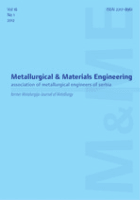
Metallurgical & Materials Engineering
Advancing the frontiers of metallurgical science.Metallurgical & Materials Engineering, published by Netherlands Press, is a prominent open access journal that has been advancing the field of metallurgical sciences and materials engineering since 2012. With an ISSN of 2217-8961 and an E-ISSN of 2812-9105, this journal provides a vital platform for researchers, professionals, and students to disseminate and access high-quality peer-reviewed research. As of 2023, it holds a Q4 quartile ranking in Mechanical Engineering and a Q3 ranking in Metals and Alloys, according to Scopus. This reflects its ongoing commitment to high standards despite being in a competitive sector. The journal covers a wide array of topics within the scope of materials science, with a focus on metallurgy and alloy technologies, and serves as a crucial resource for those engaged in innovative material development and application. Offering an open-access model emphasizes its dedication to making research widely available, thereby fostering collaboration and advancement in the materials engineering community. Join us in contributing to a dynamic and essential field of study.
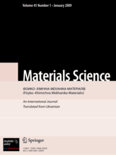
MATERIALS SCIENCE
Exploring Breakthroughs in Materials Research.MATERIALS SCIENCE, a prominent journal published by SPRINGER, serves as a vital resource for researchers, professionals, and students in the fields of materials science, mechanical engineering, and condensed matter physics. With its ISSN 1068-820X and E-ISSN 1573-885X, this journal has been dedicated to sharing innovative research since its inception in 1993, and it continues to publish groundbreaking findings through 2024. Although it operates as a traditional subscription-based journal, its ranking in the Q3 quartile across multiple scientific categories, including Condensed Matter Physics, Materials Science, Mechanical Engineering, and Mechanics of Materials, signifies its relevance and impact in the academic community. Notably, its Scopus classifications reveal a competitive standing among its peers, ranking within the 25th to 33rd percentiles across various engineering and physics disciplines. The journal remains a key platform for disseminating valuable insights, fostering collaboration, and advancing the understanding of materials science.

ACTA METALLURGICA SINICA
Empowering Innovation in Engineering DisciplinesACTA METALLURGICA SINICA, established in 1978 and published by SCIENCE PRESS, stands as a preeminent journal in the fields of metallurgy and materials science. This journal is particularly revered for its contributions to Metals and Alloys, Mechanical Engineering, Geotechnical Engineering, and Mechanics of Materials, with a commendable Q1 ranking in Metals and Alloys and notable placements in other engineering disciplines. With a robust history of facilitating scholarly communication from 1978 to 1991 and consistently since 1996, the journal provides a vital platform for researchers and practitioners to disseminate significant advancements in material science. Despite being a subscription-based journal, ACTA METALLURGICA SINICA remains pivotal, holding a Scopus ranking that places it in the top tiers of its categories, fostering an environment ripe for innovation and collaboration. This ensures that the journal remains central to the ongoing discussions and developments within the metallurgy community, serving both academic and professional interests.
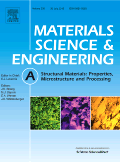
MATERIALS SCIENCE AND ENGINEERING A-STRUCTURAL MATERIALS PROPERTIES MICROSTRUCTURE AND PROCESSING
Advancing the Frontiers of Materials ScienceMATERIALS SCIENCE AND ENGINEERING A-STRUCTURAL MATERIALS PROPERTIES MICROSTRUCTURE AND PROCESSING, published by ELSEVIER SCIENCE SA, is a highly regarded journal specializing in the fundamental and applied aspects of materials science. Since its inception in 1988, this journal has established itself as a leading platform for disseminating innovative research findings, particularly focused on structural materials, their properties, microstructure, and processing techniques. With a prominent impact in the field, it ranks in the Q1 category across several disciplines including Condensed Matter Physics, Materials Science, Mechanical Engineering, and Nanoscience and Nanotechnology, highlighting its significance and influence within the academic community. The journal is accessible to a global audience of researchers, professionals, and students, underscoring its commitment to advancing knowledge in materials engineering. Aspiring authors and readers will find this journal an essential resource for cutting-edge research and the latest advancements in the field, further supported by its impressive Scopus rankings that place it among the top-tier publications.
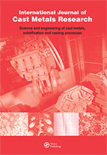
INTERNATIONAL JOURNAL OF CAST METALS RESEARCH
Pioneering Research in Cast Metals and AlloysInternational Journal of Cast Metals Research, published by Taylor & Francis Ltd, serves as a premier platform for the dissemination of cutting-edge research in the fields of Mechanical Engineering, Mechanics of Materials, and Metals and Alloys. With a commitment to advancing the understanding of cast metals, this peer-reviewed journal has achieved notable recognition, featuring a 2023 Q2 ranking in its respective categories and ranking 71st in the Materials Science field according to Scopus. Researchers and professionals will find a wealth of valuable insights through rigorous studies and innovative findings, reflecting the journal's goal of facilitating knowledge transfer and addressing contemporary challenges in material science. Furthermore, its accessible publication years from 1996 to 2024 ensure that it not only captures the evolution of technology in cast metals but also stands at the forefront of future developments. Ideal for academics and practitioners alike, the journal aims to foster collaboration and inspire new developments within the discipline.
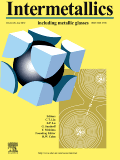
INTERMETALLICS
Connecting Chemistry and Engineering through IntermetallicsINTERMETALLICS, a prestigious journal published by ELSEVIER SCI LTD in the United Kingdom, has been a vital resource in the fields of Materials Science, Mechanical Engineering, and Chemistry since its inception in 1993. Renowned for its rigorous peer-review process and commitment to high-quality research, this journal enjoys an impressive position within the top quartile (Q1) rankings of its categories, signifying its influence and esteem in the academic community. With a particular emphasis on the study of intermetallic compounds and their applications, INTERMETALLICS attracts groundbreaking research and innovative contributions that push the boundaries of knowledge in metals and alloys, as well as mechanics of materials. Researchers looking for a platform to disseminate cutting-edge findings will find this journal an exemplary choice, further enhanced by its commendable Scopus rankings that illustrate its widespread recognition and relevance. Though it does not currently offer Open Access options, the journal remains committed to advancing the field through selective publication of impactful research, making it an essential reference for researchers, professionals, and students alike interested in the dynamic interplay between materials and engineering.
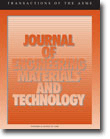
JOURNAL OF ENGINEERING MATERIALS AND TECHNOLOGY-TRANSACTIONS OF THE ASME
Elevating the discourse on materials technology and its impact.JOURNAL OF ENGINEERING MATERIALS AND TECHNOLOGY-TRANSACTIONS OF THE ASME is a premier journal published by the American Society of Mechanical Engineers (ASME), dedicated to advancing the field of engineering materials and technology. With an ISSN of 0094-4289 and E-ISSN 1528-8889, this journal has provided invaluable insights since its inception in 1973. Operating from its headquarters in New York, United States, it serves a global audience of researchers, professionals, and students alike. The journal is recognized for its rigorous peer-review process and its commitment to disseminating high-quality research, currently holding a Q3 quartile ranking across multiple categories including Condensed Matter Physics, Materials Science, Mechanical Engineering, and Mechanics of Materials. With a focus on exploring innovative materials and their applications, it aims to foster collaboration and discovery in the engineering community. Although it is not an open-access journal, it continues to play a vital role in shaping the future of engineering materials research up to 2024. Researchers and practitioners will find in this journal a significant platform to support the development and understanding of engineering materials, making contributions that resonate through academia and industry.

PHYSICS OF METALS AND METALLOGRAPHY
Unveiling the Physics Behind Metal PropertiesPhysics of Metals and Metallography, published by MAIK Nauka/Interperiodica/Springer, is a respected journal dedicated to the study of the physical properties of metals and their metallographic analysis, offering invaluable insights for researchers, professionals, and students in the fields of condensed matter physics and materials chemistry. With an ISSN of 0031-918X and an E-ISSN of 1555-6190, the journal has a rich history that spans from 1970 to 2024, reflecting a long-standing commitment to advancing knowledge in this vital area of materials science. Although it currently does not offer Open Access options, its strong placement in the academic landscape is underscored by its Q3 ranking in both Condensed Matter Physics and Materials Chemistry, according to 2023 metrics, and a Scopus ranking that places it within the competitive percentile of its fields. The journal is particularly important for those engaged in the cutting-edge research and technological applications of metals and alloys, making it an essential resource for anyone looking to deepen their understanding or contribute original findings to this dynamic discipline.
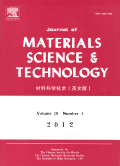
Journal of Materials Science & Technology
Advancing Innovation in Materials ScienceThe Journal of Materials Science & Technology, published by JOURNAL MATER SCI TECHNOL in China, is a leading forum for the latest research in the multidisciplinary field of materials science. With the ISSN 1005-0302 and E-ISSN 1941-1162, this esteemed journal boasts an impressive impact factor and has established itself as a vital resource for professionals, researchers, and students alike. Covering a wide range of topics, including ceramics, composites, materials chemistry, mechanical engineering, and polymers, it has achieved a coveted Q1 ranking in multiple categories as of 2023, reflecting its position in the top tier of scholarly publications. Notably, the journal excels in its Scopus ranks, placing within the top 5% in categories such as Metals and Alloys and Mechanical Engineering. Aiming to foster knowledge and innovation in material development and application, the journal is committed to facilitating groundbreaking research and collaborations that propel the field forward. With its convergence of insights from 1993 to 2025, the Journal of Materials Science & Technology remains an indispensable resource for the advancement of materials science.
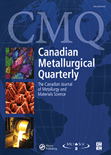
CANADIAN METALLURGICAL QUARTERLY
Pioneering Research in Materials Science.Canadian Metallurgical Quarterly is a prestigious scholarly journal published by Taylor & Francis Ltd, dedicated to the field of metallurgical engineering and materials science. With a rich history dating back to its inception in 1962 and continuing through its most recent publications, this journal serves as a vital platform for the dissemination of innovative research, advancements, and critical reviews in metallurgy, metals, and alloys. Positioned strategically within the academic community, it holds a significant impact factor and is currently rated in the Q2 category for Metals and Alloys, and Q3 in Industrial and Manufacturing Engineering as of 2023, showcasing its authoritative role in these disciplines. Although it does not offer open access, the journal remains widely recognized for its rigorous peer-review process, ensuring that published work adheres to the highest standards of scientific quality. Researchers, professionals, and students alike will find invaluable insights and contributions that drive the field forward.